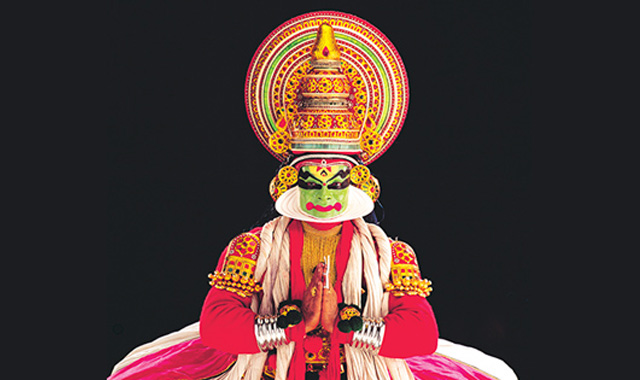Kathakali
Kathakali is a traditional dance-drama form originating from Kerala, India, known for its elaborate costumes, intricate makeup, expressive gestures, and rhythmic movements

Kathakali combines elements of dance, drama, music, and ritual to depict stories from Hindu mythology and folklore. Performances feature highly stylized movements, facial expressions, and gestures, accompanied by live percussion music and vocal recitations.
Key Aspects
1. Elaborate Costumes and Makeup
Kathakali performers wear colorful and ornate costumes, adorned with traditional jewelry and accessories. The makeup, known as "chutti," involves intricate designs painted on the face using natural pigments, creating exaggerated expressions and characters.
2. Expressive Gestures (Mudras)
Kathakali relies heavily on mudras, or hand gestures, to convey emotions, characters, and narrative elements. Each mudra has a specific meaning and significance, allowing performers to communicate complex themes without words.
3. Facial Expressions (Navarasas)
Kathakali artists master a range of facial expressions, known as "navarasas," to portray various emotions such as love, anger, joy, and sorrow. These expressions are amplified by the elaborate makeup and costumes.
4. Rhythmic Footwork and Movements
Kathakali dancers execute precise footwork and movements, synchronized with the music and rhythm of the performance. The choreography includes intricate steps, jumps, spins, and dramatic poses, enhancing the visual spectacle.
5. Narrative Themes and Stories
Kathakali performances typically depict stories from Indian epics such as the Ramayana, Mahabharata, and Puranas, as well as regional folklore and legends. The narratives are rich in symbolism, mythology, and moral teachings.
How to Enjoy Kathakali
1. Attend a Performance
Experience Kathakali live by attending a performance at a cultural center, auditorium, or temple in Kerala. Check local event listings or ask your hotel concierge for information about upcoming shows.
2. Learn About the Characters
Familiarize yourself with the characters, stories, and themes depicted in Kathakali performances. Understanding the context enhances appreciation for the art form and enriches your viewing experience.
3. Observe the Makeup Process
Arrive early to witness the intricate makeup process, where artists transform into their characters using elaborate costumes, makeup, and accessories. Some venues offer backstage tours or demonstrations before the performance.
4. Pay Attention to Expressions and Gestures
Focus on the facial expressions, hand gestures, and body language of the performers to interpret the storyline and emotions conveyed during the performance.
5. Listen to the Music
Pay attention to the live music ensemble, consisting of percussion instruments such as chenda (drum), maddalam (barrel drum), and elathalam (cymbals), as well as vocalists chanting verses and songs.
Guidelines for visitors to Enjoy Kathakali
1. Respect the Performers
Show respect to the Kathakali artists by maintaining silence and refraining from distractions during the performance. Avoid using flash photography or recording videos without permission.
2. Dress Appropriately
Dress modestly and comfortably for the performance, as Kathakali venues may have specific dress codes or cultural norms. Avoid wearing revealing clothing or attire that may disrupt others' enjoyment of the show.
3. Arrive Early
Arrive early to secure good seats and take advantage of any pre-performance activities or demonstrations. Allow time to absorb the ambiance and immerse yourself in the cultural experience.
4. Ask Questions
Don't hesitate to ask questions or seek clarification about the performance, characters, or traditions from the organizers or knowledgeable locals. Learning about Kathakali enhances your appreciation for the art form.
5. Support Local Artists
Consider purchasing souvenirs, artwork, or recordings of Kathakali performances to support local artists and promote the preservation of this traditional art form.
By following these guidelines and immersing yourself in the mesmerizing world of Kathakali, you can enjoy a captivating and culturally enriching experience during your visit to Kerala.
Would you find this information useful? Please Share & Support
Like us on Facebook for all the latest recipes